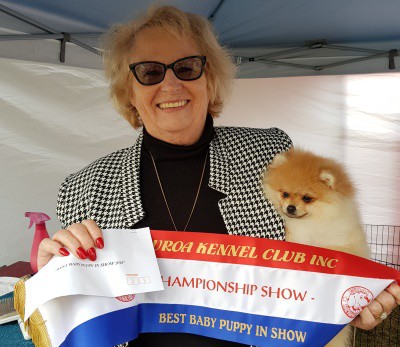Last Updated on July 28, 2020 by Denise Leo. Post first published on November 18, 2015.
The Chinook dog was developed as a sled dog in the United States. His function was sled dog races and drafting. He was bred to mix the speed of lighter sled dogs and the strength of freighting dogs.
He’s a very athletic dog with a hard body. He has great rear extension and forward reach in his endless gait. He has an impressive look, black eye markings, dark almond eyes and an aquiline muzzle. His ears sit in various different positions and his coat is a close fitting fawn colour. His saber tail is generally displayed as a graceful sickle curve.
The male Chinook is significantly different from the female of the species. The female has a feminine look and needs to be judged on equal footing with the males. This dog should be presented without trimmings and in a natural condition.
This breed is a family dog that demonstrates lots of affection and is keen to please. He’s playful, versatile, easy to train and loves children. He loves lots of regular exercise including daily walks and other activities including: hiking, backpacking, jogging and a sport called skijoring (a winter sport where a dog pulls someone behind him who’s on skis. He loves a fenced in yard so he can play when you’re busy.
He’s NOT a good guard dog as he has poor protective instincts. His thick double coat is a seasonal shedder so he must have regular washing and brushing to minimise shedding.
A Chinook puppy needs to socialise to help boost his confidence. This includes taking him to a puppy class.
Nutrition and feeding.
What and how much and how often you feed your adult dog depends on numerous factors. You’ll need to create the right formula designed to meet his ever-changing, individual digestive needs as he grows older. Numerous dog food manufacturers have created breed-specific formulae for all sizes and breeds.
The Chinook usually lives between 11-13 years. You’ll decide what to feed him but you should consult your vet and/or breeder to learn what and how much to feed you’re your dog, as a puppy and as an adult. He should have access to plenty of fresh, clean, drinking water whenever he needs it.
Coat and grooming.
This breed’s double thick coat will shed hair according to the seasons so regular brushing and bathing can minimise this. Use a decent slicker brush during the season for shedding. Nails should be regularly trimmed by using either a grinder or nail clipper to help avoid cracking, splitting and overgrowing. Ears must get a regular check-up so debris and wax stands zero chance of building up and possibly causing infections. Chinook teeth must be regularly brushed to keep them clean.
Chinook and Health.
As with all dog breeds, a Chinook may have health problems such as: eye disease, hip dysplasia or patellar subluxation. Having said that, the good news is that most Chinooks are very healthy.
Colour: The Chinook has a general tawny colour but it ranges from a deep reddish-gold colour through to a pale honey shade. This is a Chinook’s distinguishing characteristic. A diluted tawny colour and the dilated pigments around the eye rims, on the pads of his feet and on his lips and nose. While this is acceptable, it’s certainly not ideal.
It’s highly desirable that the muzzle and ear colouring is a darker shade than that of the dog’s body. It runs from a darker tawny to a shade of black; some black shading is very much preferred.
In the inner corner of both eyes, it’s highly desirable that there’s a black apostrophe- shaped mark. It’s acceptable for there to be symmetrical pale to gold or white markings on the cheeks, underside, breeches, chest and throat. Any other white marks aren’t acceptable. This includes: scarves, socks and blazes.
The Chinook must be a tawny colour, as other colours are a disqualification.
Ideal measurements are as follows:
Females= 22-24 inches. Males= 24-26 inches.
Copyright CaninePals.Com. All Rights Reserved.


